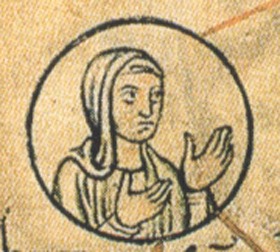ClarissimaFemina

Detail from the Chronica sancti Pantaleonis:
Hedwig of Saxony - One of my 31st Great-Grandmothers
(12th century)
" … and sometimes even saints."
I have been delighted to discover that many of my Great-Grandmothers were famous or notorious enough to warrant getting their picture taken during their time. Before cameras, sketches were photos, and so were pottery, paintings, and sundry engravings. Almost every female in my Fambly tree between 500AD and the fifteenth century left some graven image ranging from pottery chard to Eleanor Crosses. None of these images were very likely true to their subject. I suspect that most were idealized and iconic, likely attempting to represent a most prominent attribute, be that an unusually large nose or blond hair, such that anyone who'd heard their legend might readily feel as though they recognize the image. Yes, most of these women also have some legend attached to them.
I think it is tragic that history continues primarily from a patrilineal perspective. It would undoubtedly be more confusing but enlightening if we focused more on matrilineal threads, for the females were often far more influential in antiquity than we usually believed them to have been. Fortunately, many of my great-grandmothers now have Wikipedia® pages dedicated to their stories, so I have a decent source. In truly ancient times, The Romans referred to these women as Clarissima Femina or Most Splendid Women. Syagria, one of my 47th Great-Grandmothers, serves as an exceptional and, therefore, perfect example. Born around 390 AD, she was the daughter of a Roman noble, Flavius Afranius Syagrius, who was proconsul of Africa in 379, Praetorian prefect of Rome in 380 and 382, prefect of Rome in 381, and consul in 382. Her son, Tonantius Ferreolus, one of my 46th Great-grandfathers, became the praetorian prefect of Gaul. He married Papianilla, a niece of Emperor Avitus, and, herself, also a Most Splendid Woman. I'll bet holiday meals were interesting around their place!
If one needed a little more regality in their monarch, this was accomplished by marrying them off to someone with exquisite blood, even if said exquisite was a two-year-old at the time. Love had very little to do with marriages then. They were life-sized chemistry experiments carried off across generations. In practice, these females often performed like one of Douglas Adams' Improbability Generators. They injected some unanticipated difference into the mix, sometimes resulting in a particularly belligerent heir and usually producing some next-generation Improbability Generators to marry off before they could walk. These 'mere' wives, particularly in the earlier years, the so-called Dark Ages, might become co- or even sole rulers of their kingdoms after their husbands were killed in the odd Crusade or just in one of their seemingly never-ending tussles with neighboring vassals. Sometimes, they'd become the caretaker of the kingdom until the inheritor achieved the age of majority. They sometimes wielded subtle power and profound influence.
These extraordinary women were all the more exceptional because they so often managed to find power without ever having been formally granted any. Most had been schooled, a rarity regardless of gender in the mid-twelfth century, and they studied their forebears’ histories and languages well. Indeed, educated women were often much better oriented than even their most regal counterparts because kingly schooling focused so intensely on learning how to fight. They'd concentrate on jousting while their little sisters mastered the more diplomatic arts. They could, therefore, talk their husbands out of their most treasured possessions by employing their wily arts of persuasion.
The men were in charge, if only formally, and they often behaved abysmally. Between their wars and concubines, they could become rather single-minded. They were capable of trading wives like a teenager might trade Pokemon cards, though they might require papal permission to execute the switches. One of my more son-of-a-bitch forebears grew tired of his third wife, and so he and his advisers concocted an excuse to hand deliver to Rome and into the hands of the reigning pope. It seems that this wife was this king's second cousin! How could this shocking oversight have originally happened? When presented with this evidence, the pope reminded this king that his immediate predecessor had granted him an intercession to marry this woman even though she happened then to have been his second cousin. Besides, the pope continued, saying that this king had already asked for and received three intercessions and would not be receiving more. He was dismissed with a rejection of his request and a papal injunction to figure out how to get along with this one. Surprisingly, he did.
It was the practice back in the Dark side of the Middle Ages for queens to retire if they survived their baby-rearing years to live in a convent somewhere. Even Charlemagne, one of my thirty-seventh great-parents, and his wife Hildegard de Vintzgau Herstal retired from their castle to monastery and convent. It was also not unheard of for such retiring vassals and consorts to be later beatified for their efforts. It might be that the more modern royals become entirely too shopworn to be seriously considered for sainthood upon retirement. Then, founding a convent or monastery helped solidify the pope's hold on territory, so a beatification sometimes resulted from the rough equivalent of a continuing campaign contribution. In Citizens United language, monasteries and convents must have been people, too, and sometimes even saints.
©2024 by David A. Schmaltz - all rights reserved


